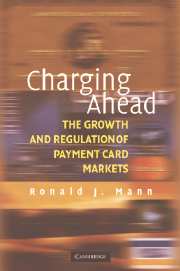Book contents
- Frontmatter
- Contents
- Figures and Tables
- Acknowledgments
- Introduction
- PART I THE BASICS OF PAYMENT CARDS
- PART II EASY MONEY
- PART III THE PUZZLE OF PAYMENT CARDS
- 6 Explaining the Pattern of Global Card Use
- 7 The Introduction of the Payment Card
- 8 Revolving Credit
- 9 Point-of-Sale Debit
- 10 Convergence and Exceptionalism in the Use of Cards
- PART IV REFORMING PAYMENT SYSTEMS
- PART V OPTIMIZING CONSUMER CREDIT MARKETS AND BANKRUPTCY POLICY
- Conclusion
- Appendix: Country-Level Data
- Notes
- Bibliography
- Index
8 - Revolving Credit
Published online by Cambridge University Press: 06 July 2010
- Frontmatter
- Contents
- Figures and Tables
- Acknowledgments
- Introduction
- PART I THE BASICS OF PAYMENT CARDS
- PART II EASY MONEY
- PART III THE PUZZLE OF PAYMENT CARDS
- 6 Explaining the Pattern of Global Card Use
- 7 The Introduction of the Payment Card
- 8 Revolving Credit
- 9 Point-of-Sale Debit
- 10 Convergence and Exceptionalism in the Use of Cards
- PART IV REFORMING PAYMENT SYSTEMS
- PART V OPTIMIZING CONSUMER CREDIT MARKETS AND BANKRUPTCY POLICY
- Conclusion
- Appendix: Country-Level Data
- Notes
- Bibliography
- Index
Summary
For current purposes, the turning point in the history of the credit card was in the 1960s when banks recognized the potential for profiting from the issuance of payment cards and began to offer products that competed with Diners Club and American Express. Bank of America created the BankAmericard in 1958, a product that eventually evolved into the Visa system. In 1966, a group of card-issuing banks, fearing the competitive ramifications of joining the Bank of America network, established their own network, which eventually developed into MasterCard. The most interesting part of that story is that the credit card product went to market and was able to survive. In truth, the question is not why the revolving credit card has been slow to catch on outside the United States, but how it ever managed to succeed in the United States.
In thinking about the rise of the Visa and MasterCard networks, it is important to understand the dual-issuer system in which many banks for decades issued cards under both Visa and MasterCard brands. Dual issuance has diminished in recent years because Visa has enforced an exclusivity rule for debit cards. The government more or less unintentionally created the dual-issuance system in the 1970s when it decided not to permit Visa to exclude MasterCard members. Most observers believe that this decision led to relatively weak competition between what have become the two dominant networks.
- Type
- Chapter
- Information
- Charging AheadThe Growth and Regulation of Payment Card Markets around the World, pp. 86 - 92Publisher: Cambridge University PressPrint publication year: 2006

